Themed collection Editor’s Choice: Nanomaterials for catalysis

Graphene-based transition metal oxide nanocomposites for the oxygen reduction reaction
Recent advances in the studies of oxygen reduction reaction (ORR) on graphene-based transition metal oxide nanocomposites are reviewed with emphasis on the morphologies and interactions between graphene and the supported component.
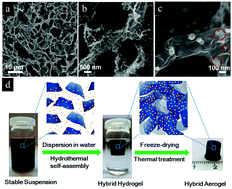
Nanoscale, 2015,7, 1250-1269
https://doi.org/10.1039/C4NR05838K
Heterogeneous catalytic conversion of CO2: a comprehensive theoretical review
This review illustrates current computational approaches to finding catalytic materials for CO2 thermocatalytic and electrocatalytic reduction.

Nanoscale, 2015,7, 8663-8683
https://doi.org/10.1039/C5NR00092K
Metal–organic framework composites: from fundamentals to applications
The composition of MOFs not only shows enhanced properties, but also broadens the applications of MOFs to new fields owing to the interactions of functional species with the MOF structures. This review will discuss the fabrication, properties, and applications of MOF composites. The remaining challenges and future opportunities in this field have also been indicated.
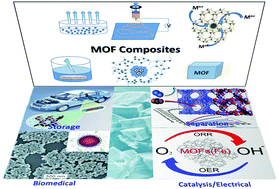
Nanoscale, 2015,7, 7482-7501
https://doi.org/10.1039/C5NR00518C
Hollow CoP nanopaticle/N-doped graphene hybrids as highly active and stable bifunctional catalysts for full water splitting
Hollow CoP nanopaticle/N-doped graphene hybrids as highly active and stable bifunctional catalysts for full water splitting are favorably comparable to the performance of Pt/C and IrO2.
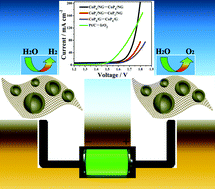
Nanoscale, 2016,8, 10902-10907
https://doi.org/10.1039/C6NR01867J
Electrodeposited Co-doped NiSe2 nanoparticles film: a good electrocatalyst for efficient water splitting
Co-doped NiSe2 nanoparticles film electrodeposited on Ti plate (Co0.13Ni0.87Se2/Ti) acts as a robust water-splitting electrocatalyst in 1.0 M KOH, driving 10 mA cm−2 at HER overpotential of 64 mV and 100 mA cm−2 at OER overpotential of 320 mV.
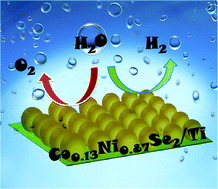
Nanoscale, 2016,8, 3911-3915
https://doi.org/10.1039/C5NR07170D
NiCo2S4 nanowires array as an efficient bifunctional electrocatalyst for full water splitting with superior activity
The present communication reports the topotactic conversion of a NiCo2O4 nanowire array on carbon cloth (NiCo2O4 NA/CC) into NiCo2S4 NA/CC, which is used as an efficient bifunctional electrocatalyst for water splitting with good durability and superior activity in 1.0 M KOH.

Nanoscale, 2015,7, 15122-15126
https://doi.org/10.1039/C5NR04064G
Few-layered MoS2 nanosheets wrapped ultrafine TiO2 nanobelts with enhanced photocatalytic property
A heterostructured photocatalyst comprised of few-layered MoS2 nanosheets coated on a TiO2 nanobelts surface was synthesized through a simple hydrothermal treatment.
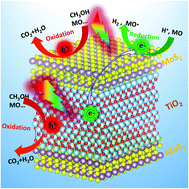
Nanoscale, 2016,8, 6101-6109
https://doi.org/10.1039/C5NR08796A
Comparison of liquid exfoliated transition metal dichalcogenides reveals MoSe2 to be the most effective hydrogen evolution catalyst
We compare the catalytic performance of electrodes consisting of porous arrays of liquid exfoliated MX2 nanosheets (M = Mo, W; X = S, Se, Te) and find a clear hierarchy with selenides > sulphides > tellurides.

Nanoscale, 2016,8, 5737-5749
https://doi.org/10.1039/C5NR08553E
In situ plasmonic Ag nanoparticle anchored TiO2 nanotube arrays as visible-light-driven photocatalysts for enhanced water splitting
An ultrasonication-assisted in situ deposition strategy was developed to realize uniform Ag nanoparticles dispersed on TiO2 nanotube arrays (Ag@TiO2 NTAs).
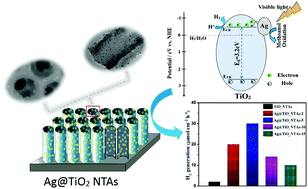
Nanoscale, 2016,8, 5226-5234
https://doi.org/10.1039/C5NR08341A
Improving the photocatalytic hydrogen production of Ag/g-C3N4 nanocomposites by dye-sensitization under visible light irradiation
Fluorescein-sensitized Ag/g-C3N4 nanocomposites have a remarkably enhanced photocatalytic activity for hydrogen production under visible light.
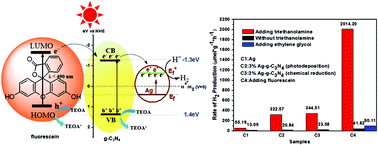
Nanoscale, 2016,8, 2249-2259
https://doi.org/10.1039/C5NR06346A
Tuning the surface oxygen concentration of {111} surrounded ceria nanocrystals for enhanced photocatalytic activities
The surface oxygen concentration of {111} exposed sub-10 nm sized ceria nanocrystals was tuned by indium doping for achieving excellent photocatalytic activities.
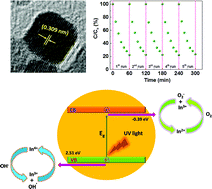
Nanoscale, 2016,8, 378-387
https://doi.org/10.1039/C5NR06588G
Cobalt sulfide/N,S codoped porous carbon core–shell nanocomposites as superior bifunctional electrocatalysts for oxygen reduction and evolution reactions
Core–shell cobalt sulphide/N,S-codoped porous carbon nanocomposites exhibit excellent electrocatalytic activities in both ORR and OER with superior durability.
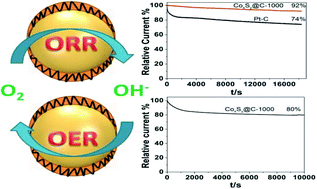
Nanoscale, 2015,7, 20674-20684
https://doi.org/10.1039/C5NR07429K
The synergistic role of carbon quantum dots for the improved photocatalytic performance of Bi2MoO6
Novel carbon quantum dot (CQD) modified Bi2MoO6 photocatalysts were prepared by a facile hydrothermal process. The key roles of CQDs in the enhanced photocatalytic performance were explored in detail.
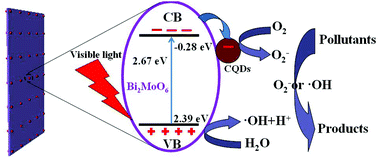
Nanoscale, 2015,7, 11433-11443
https://doi.org/10.1039/C5NR01350J
Influence of electron storing, transferring and shuttling assets of reduced graphene oxide at the interfacial copper doped TiO2 p–n heterojunction for increased hydrogen production
Herein we report a Cu2O–TiO2/rGO photocatalyst with phenomenal water splitting ability.
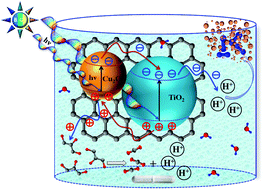
Nanoscale, 2015,7, 7849-7857
https://doi.org/10.1039/C5NR00504C
The support effect on the size and catalytic activity of thiolated Au25 nanoclusters as precatalysts
6-mercaptohexanoic (MHA) protected Au25(MHA)18 nanoclusters deposited on HAP, Degussa P25, AC, PGO and fumed SiO2 were all prepared via a conventional impregnation method.
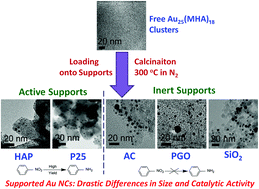
Nanoscale, 2015,7, 6325-6333
https://doi.org/10.1039/C5NR00549C
Porous metallic MoO2-supported MoS2 nanosheets for enhanced electrocatalytic activity in the hydrogen evolution reaction
Porous metallic MoO2-supported MoS2 nanosheets exhibit excellent electrocatalytic activity for HER and robust electrochemical durability.

Nanoscale, 2015,7, 5203-5208
https://doi.org/10.1039/C4NR06754A
Water-assisted production of honeycomb-like g-C3N4 with ultralong carrier lifetime and outstanding photocatalytic activity
Honeycomb-like g-C3N4 synthesized via thermal condensation of urea with the addition of water at low temperature, with ultralong carrier lifetime and outstanding photocatalytic activity for NOx removal.
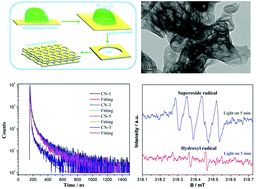
Nanoscale, 2015,7, 2471-2479
https://doi.org/10.1039/C4NR05732E
Co3O4 nanoparticles decorated carbon nanofiber mat as binder-free air-cathode for high performance rechargeable zinc-air batteries
A facile method is developed for the fabrication of Co3O4 nanoparticles decorated carbon nanofibers, which enable significant improvement of rechargeable Zn-air batteries with respect to rate capability, cycling stability and energy density.
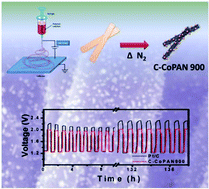
Nanoscale, 2015,7, 1830-1838
https://doi.org/10.1039/C4NR05988C
Fe/N/C hollow nanospheres by Fe(III)-dopamine complexation-assisted one-pot doping as nonprecious-metal electrocatalysts for oxygen reduction
Hollow nanospheres with N-doped carbon shells and Fe3O4 nanoparticles prepared by one-pot doping exhibit excellent electrocatalytic performances for ORR.
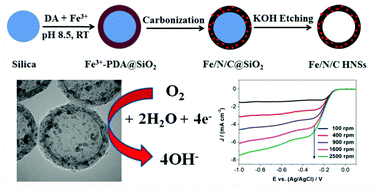
Nanoscale, 2015,7, 1501-1509
https://doi.org/10.1039/C4NR06366J
Ionic liquid self-combustion synthesis of BiOBr/Bi24O31Br10 heterojunctions with exceptional visible-light photocatalytic performances
BiOBr/Bi24O31Br10 heterojunctions are fabricated via ionic liquid self-combustion and show exceptional adsorptive and photocatalytic activities towards cationic and anionic dyes.
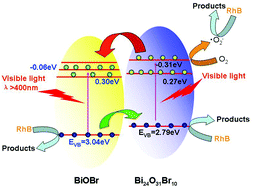
Nanoscale, 2015,7, 1116-1126
https://doi.org/10.1039/C4NR05451B